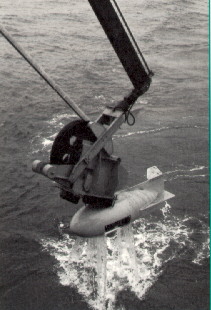
In a technique borrowed from bats and dolphins, hydroacoustics involves sending out a stream of sound pulses, then interpreting the echo as these sounds rebound from objects in the water. The process is much like sight. Just as our eyes see patterns of reflected light, and our brains interpret these patterns, hydroacoustics allows us to "see" underwater by interpreting patterns in reflected sound.
Whales and dolphins do this from birth, and rely much more on sound than sight. Humans are much less gifted in this regard. We have to make the acoustic data visible, and filter it through elaborate computer processes, to distinguish what the echoes can reveal.
Five years of sustained funding from the Northern Cod Science Program has made it possible to refine the application of acoustics in stock assessment and studies of fish behaviour in the Northwest Atlantic. This work has involved both the design and testing of new instruments, and the development of new techniques in their application.
Interpreting acoustic echoes requires a knowledge of the acoustic properties of different kinds of fish under various conditions. To make full use of this technique in fisheries research, we have to know a lot about what fish "look like", acoustically.

Sounds penetrate most materials, but a fraction of the sound will reflect from any abrupt change in density. In fish, the most reflective surface is not the body itself but the swim bladder: the inner balloon fish use to regulate their buoyancy. To sound waves, the contrast between flesh and a bladder full of air is much more distinct than the contrast between water and flesh, so most of the echoes from fish come from the swim bladder. If this were a sphere, it would look the same from every angle, but most swim bladders are oblong, much smaller in one dimension than another. So one element of the acoustic research has been to study how changes in the position of fish, relative to the direction of the sound beam, affect the strength of the echo.